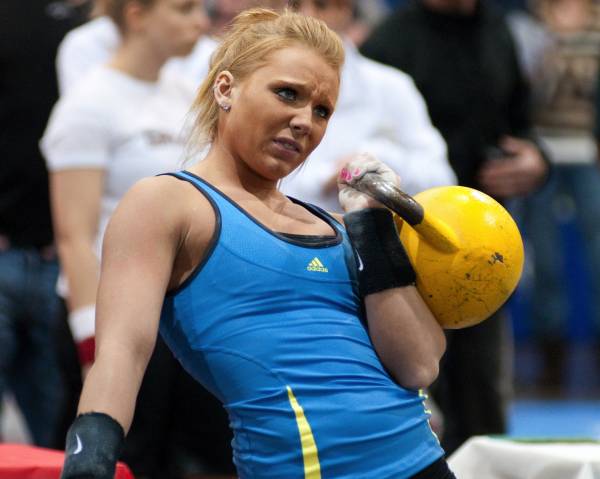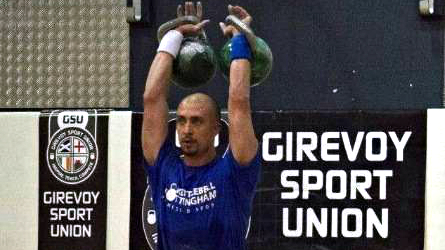When your love for a sport is all consuming and you live it and breathe it every day with a passion, it can be easy to forget that not everyone understands what it is about, or even knows about it. That happens to me a lot. Kettlebell sport is ingrained deeply in my life.
When your love for a sport is all consuming and you live it and breathe it every day with a passion, it can be easy to forget that not everyone understands what it is about, or even knows about it. That happens to me a lot. Kettlebell sport is ingrained deeply in my life.
I train for kettlebell sport, I coach my athletes in it, and I write about it. My wife is also a kettlebell lifter and coach. So you can imagine that I can still be taken by surprise when someone tells me they haven’t got a clue about kettlebell sport. But I’m always happy to explain.
Me at a kettlebell sport competition.
Kettlebells: Not Just for Fitness
Most gym goers and trainers have experienced kettlebells. These peculiar looking weights are not the novelty they were ten years ago and now have a place in many training facilities. However, most people only have seen and been taught to use these cannonballs with handles as a fitness tool. Many athletes remain oblivious that they have been used for over sixty years as integral tool of a fully-fledged sport.
“The two main disciplines of the sport are the biathlon (which is comprised of two separate events, the jerk and the snatch) and the long-cycle which is clean and jerk.”
The first official girevoy sport (the original Russian name of the sport) competition was held in 1948 in the old USSR and it developed from there across the 1950s and ‘60s. This advancement came mainly from the military, who had seen how this form of training benefited the troops. In the ‘70s, girevoy sport entered the National Sports Federation as the official ethnic sport of Russia.
It began gaining popularity in Britain around the second half of the 2000s, and after being an underground sport for a few years, now has competitions organised and sanctioned by national bodies such as the Girevoy Sport Union and the Organization of Kettlebell Sport England. In the U.S., the United States Girevoy Sport Federation was founded in 2003.
What Is Kettlebell Sport?
The best way to describe it is “endurance weightlifting.” The two main disciplines of the sport are the biathlon (which is comprised of two separate events, the jerk and the snatch) and the long-cycle which is clean and jerk.
“Training methodologies vary greatly from athlete to athlete and from coach to coach; however, the one principle that does not change is the requirement for supreme efficiency.”
All lifts are carried out for a maximum of ten minutes in which the athletes aim to complete as many quality reps as possible without placing the kettlebell(s) on the ground. Whoever has the highest amount of reps is deemed the winner. In biathlon there must be at least thirty minutes break between the jerk and the snatch.
Men complete the jerk portion of the biathlon and the long-cycle with two kettlebells, while women traditionally use only one kettlebell, although more and more ladies are choosing the two-arm lifts nowadays. The snatch is contested using one kettlebell in both male and female categories. Whenever using one kettlebell, be it in the snatch (for both gender categories), or in the women’s jerk and long-cycle, the athletes are allowed to change hands only once during the set.

The best way to describe kettlebell sport is “endurance weightlifting”.
How Heavy Are Those Things?
Kettlebell weights used in the men’s category usually are 16kg, 20kg, 24kg, 28kg, and 32kgs. Women use 8kg, 12kg, 16kg, 20kg, and 24kg. These are for local events in the UK, and for national events.
The choice of kettlebell weights decreases dramatically at international level. Here lifters are divided into two categories, amateur and professional. Male amateurs use the 24kg kettlebells, while women use the 16kg kettlebell. Professional male athletes compete with the 32kg kettlebells, while the professional women use the 24kg bell.
“All the lifts are performed aiming to use only the exact amount of energy needed and using momentum to the lifter’s advantage during the concentric phase.”
There is normally also a veteran category at international competitions. The weights used can vary depending on the federation under which the meet is being held and also with the lifters age. Normally veteran males use the 24kg and women the 16kg.
At the moment, women’s competition at international level only involves snatch. This may well change soon given the fast-changing landscape of the sport. It is also important to note that athletes compete in bodyweight categories. Men start at 63kg and go up to 95+kg and women begin at 53kg up to 68+kg.
The Preparation of a Kettlebell Sport Athlete
Training methodologies vary greatly from athlete to athlete and from coach to coach; however, the one principle that does not change is the requirement for supreme efficiency.
Without efficient technique it is not possible to achieve the high numbers of repetitions required to be successful in the sport. All the lifts are performed aiming to use only the exact amount of energy needed and using momentum to the lifter’s advantage during the concentric phase. To achieve such efficient technique, the jerk, snatch, and long cycle need to be patiently and consistently drilled.
“The sport requires specific flexibility, muscular strength endurance, power endurance, and a well-developed aerobic capacity, so all of these components should be present in the athletes GPP program in some way.”
The eccentric portion of the lift is reduced to a minimum. This also explains the relatively small amount of hypertrophy seen in kettlebell sport athlete when compared to powerlifters or Olympic weightlifters, despite the vast amount of weight lifted in each session.
In terms of GPP, the needs of each athlete will be different. The sport requires specific flexibility, muscular strength endurance, power endurance, and a well-developed aerobic capacity, so all of these components should be present in the athletes GPP program in some way.
Tips for Getting Started
To anyone interested in competing, I recommend seeking out a reputable coach so you can learn the technical details of the lifts and how to best program training cycles. If you cannot find a coach close to you, then seek a coach who offers online training. Just make sure he or she has a proven record on the platform, either personally or through athletes.
The best way to get involved in kettlebell sport in the United States is to check out the United States Girevoy Sport Federation to find out about when and where competitions are held. A great first step is simply to go and watch a competition, and get a feel for the sport. Good luck, and I’ll see you on the platform.
More Like This:
Photo 1 courtesy of Laurence Clemente.
Photo 2 courtesy of Shutterstock.
